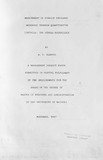| dc.description.abstract | Most non-oil developing countries have in
recent times experienced foreign exchange reserve
shortages and deficits in their current .accounts
implying that they import, more than they export.
One of the major reason s for foreign exchange
problems in these countries is the unfavourable
international trade position in which they find
themselves in. They are engaged in a trade
pattern which is characterised by exports which
are dominated by products like coffee, tea, sisal,
pyrethrum and horticulture which are characterised
by high price elasticities of demand in the
world market and unstable prices.
On the other hand, most of these non-oil
developing countries are unable to produce efficiently
many of the goods and services required
to promote their economic development. This means
that these countries have to look beyond their
borders for items necessary to develop their
economies to levels at which they can produce these
goods and services. These imports must be paid
for. Many non-oil developing countries have
found it difficult to finance imports due to the
problem of inadequate foreign exchange reserves.
In the face of overwhelming balance of payments
problems, these countries have resorted to
enormous external debt on severe terms, thus
raising their debt servicing burdens to almost
unmanageable proportions. Faced by this situation,
SDme of these countries have found it necessary
to introduce foreign exchange control regimes
in an attempt to conserve foreign exchange.
This paper attepts to analyse the quantitative
foreign exchange control system as a tool
of managing foreign exchange reserves in Kenya.
The study critically examines the administrative
framework within which the quantitative control
system
operates. The import liberalization
process in the country is also examined.
Data for the study was obtained from the
Central Bank of Kenya and the Ministries of Finance;
Economic Planning and National Development; and
Commerce. The collection of data was personally
done by the researcher. The data collected included
import licence approvals, foreign exchange
releases by Central Bank of Kenya, classification
of import items by schedules, global allocation
of foreign exchange by schedules and the value
of actual imports as provided by Customs Office.
The data was in the form of computer print-outs.
The findings indicated that:-
(a) During the course of the implementation of
the quantitative restrictions on imports,
policy makers recognised that some problems
were generated by the system. Some of the
adverse effects of the system were that it
encouraged slack management and inefficiency
which reduced the ability of local firms to
export. This made the country's exports less
competitive in world markets both because
of high prices and poor quality. In response
to these problems, the government introduced
the policy of liberalization in 1980. The
restrictive import licensing was gradually
to be replaced with tariffs.
(b) At least more than 65% of the restricted
import items have been liberalized or shifted
to the priority schedules. However, the rate
at which these items have been liberalized
has been slower than planned.
(c) There is no transparent criteria of approving
or rejecting an import application. The
system is open 'to abuse and corrupt practices.
(d) The annual foreign exchange allotment system
has not been implemented as planned.
(e) There is lack of co-ordination between the
institutions involved in processing import
licences.
Due to limited time that was available to
the author, the study does not analyse the
aggregate demand for foreign exchange which
would have assisted in assessing the adequancy
of the current tariff and sale tax rates.
There is no doubt that substantial progress
has been made towards the liberalization of the
import administration. However, it is recommended
that the import licensing system be made as
transparent as possible to reduce opportunities
for bribery and corruption and to facilitate
administration'. Clear guidelines would also
minimise the civergence in the decisions made
by the institutions involved in processing
import licence applications | en |

